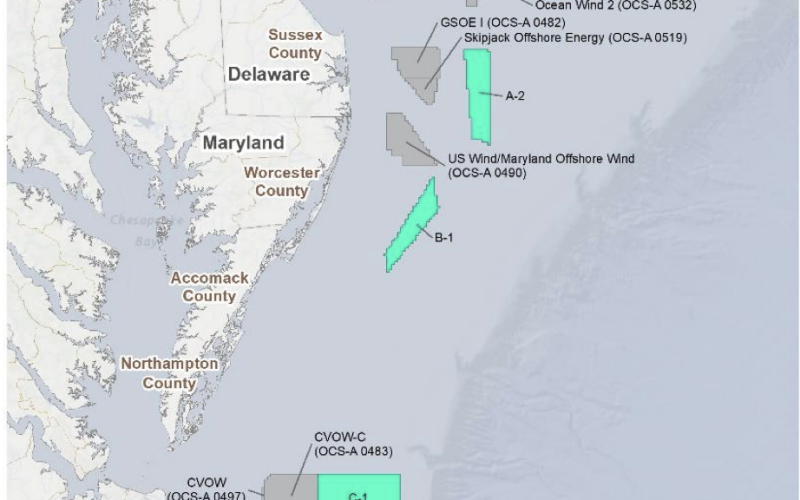An environmental assessment of three planned offshore wind energy areas off Delaware, Maryland and Virginia predicts “no significant impacts” from future lease sales on 365,545 acres of seafloor, the federal Bureau of Ocean Energy said this week.
Dubbed the Central Atlantic region by BOEM planners, lease sales are already tentatively scheduled for Aug. 14, and the environmental study summarizes “site assessment and site characterization activities such as geophysical, geological, and archaeological surveys,” according to an agency announcement. “The EA concluded that there would be no significant impacts from lease issuance.”
BOEM Director Elizabeth Klein said the agency will work with other government agencies, ocean users and the public “to ensure that any development in the region is done in a way that avoids, reduces, or mitigates potential impacts to ocean users and the marine environment.”
Supporting documents to the environmental assessment do note caveats. Potential conflicts with U.S. military uses and NASA’s Wallops Flight Facility in Virginia are continuing to be assessed for Wind Energy Area B-1 off Maryland and Virginia.
That process “will be used to inform whether WEA B-1 should be included in a potential second lease sale, which would be the next step in the wind energy process,” according to one agency document. If B-1 is included in a proposed lease sale, bidders would be notified of any necessary mitigation before a future sale.
BOEM planners have found “that would be that the magnitude and cost of collective mitigation needed to accommodate offshore wind construction and operations in this area would be significant,” the document notes.
Impact on the fishing industry is another concern, and BOEM earlier shifted its consideration of potential wind development areas to avoid some scallop and surf clam areas. If the future leases are developed, the National Marine Fisheries Service has estimated that “up to 24% of total average revenue for major Mid-Atlantic commercial species in lease areas through disruption and displacement, if all lease areas considered in the NOAA assessment.”
However that earlier 2021 study “included over 20 projects and covered a larger area than considered in this EA,” the document notes. “These effects may arise from met buoys, foundations, scour/cable protection, and transmission cable infrastructure, and some disruption effects may be unavoidable.”
BOEM and NMFS anticipate “moderate adverse impacts, because some commercial and recreational fishing would experience disruptions even if remedial action were taken, and others would have to adjust to account for disruptions and space-use conflicts due to impacts.”
As for impact on most marine mammals and protected species, “the overall effect would be unavoidable, as some individuals will likely experience disturbances, but the majority of affected individuals would be expected to fully recover, and no population-level impacts will occur among marine mammals of the Central Atlantic,” according to the agencies.
But one critical exception is the highly endangered North Atlantic right whale, with only around 360 animals surviving.
“Given the NARW’s declining population status and environmental baseline impacts from vessel traffic and fisheries gear interactions, serious injury or loss of an individual would result in population-level impacts that threaten the viability of the species if a vessel strike or entanglement were to occur,” the document notes.




